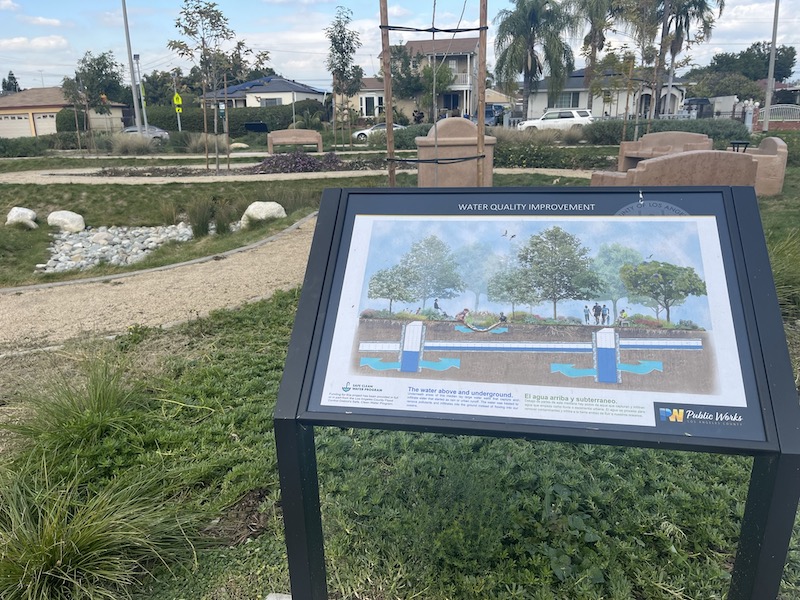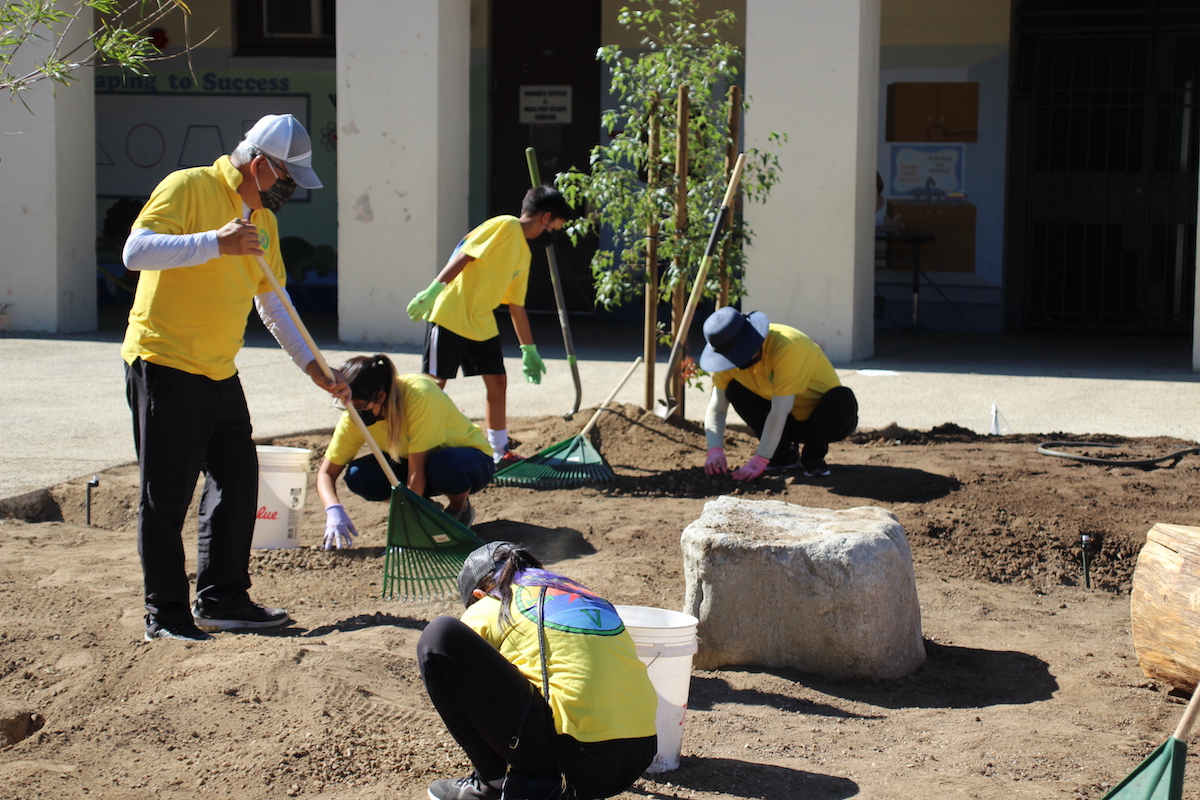(Above: LAUSD students plant trees as part of efforts to create more permeable landscapes to bolster LA’s water supplies. Image courtesy of Amigos de los Rios.)
In 2018, L.A. County voters overwhelmingly – with a 70% plurality – approved Measure W, a parcel tax that has since provided more than $1 billion for water infrastructure projects.
Now it’s time to audit that Safe Clean Water Program (SCWP), as the measure mandates.
In preparation for that, Los Angeles Waterkeeper, a nonprofit that helped conceive of and promote Measure W, has issued “Changing the Course,” a 47-page report studying SCWP’s accomplishments and emerging challenges.
“We have to celebrate success,” said Bruce Reznik, executive director of LA Waterkeeper, at a Feb. 16 briefing to present the report. “This is an incredibly complicated program that we got running in less than a year. But it’s also time to identify areas for improvement.”
Measure W imposes a parcel tax of 2.5-cents per square foot of “impermeable hardscape,” such as asphalt. The report only looked at half of the $280 million annually accrued from the tax that goes to a competitive grant program supporting multi-benefit storm-water projects.
The $1 billion allocated to grant applicants so far includes $368 million of additional local, state and federal contributions. To date, it has funded 101 proposals, 63% of those submitted, that should net more than 4,000 tree plantings, almost 400,000 gallons of stormwater capture from a typical day-long rainstorm – enough to supply more than a half-million people – and the removal of more than 30 acres of hardscape.

The report details 20 of those 101 current projects.
Reznik was joined in the presentation by Claire Robinson, managing director of Amigos de los Rios, and Mark Gold, adjunct professor at UCLA’s Institute of the Environment & Sustainability and Director of Water Scarcity Solutions with the National Resources Defense Council (NRDC).
Schools an attractive opportunity
Among the challenges and room for improvement they suggested are better tracking of accomplishments and much more emphasis on transforming hardscape to greenscape.
The report notes that Los Angeles’ 10 million people live in one of the country’s most “park-poor” environments, with only 3.3 acres of park per 1,000 people — when the national average is 10 acres — and with 51% of the population living at least a half-mile from any park.
But schools offer an attractive opportunity for making big gains. As far back as 1930, Robinson said, the Olmsted-Bartholomew Plan proposed that “every single school” should be designed to also serve as a park. This would align perfectly with Measure W’s mandate that projects be multi-benefit and prioritize underserved communities, as 36% of those approved so far do.
“We feel that schools are such a critical place for this whole narrative of water scarcity and living within our water budgets,” Robinson said. Besides bringing science and technology lessons to life as a “living laboratory for students,” she said, greening Los Angeles’ thousands of schools benefits students physically and immediately by remediating the “heat island” effect that can see temperatures on asphalt schoolyards soar well beyond 100 degrees.
“They have better outcomes when they’re back in math class. They can perform and are less subject to anxiety.”
The goal, she said, is to take out from 60% to 70% of playground asphalt and 30% from campuses overall, to be replaced with “a new menu of materials” such as pervious concrete – “a fabulous material, something the county needs to be more aware of,” Robinson said.

Nature based solutions
California’s “huge focus” on nature-based solutions and the federal government’s new focus on infrastructure improvements make this an historically opportune time for this work, Gold said.
“We’ve had investments in parks at the county scale that we’ve never really had in this reliable manner before,” he said.
Currently, in Los Angeles, 60% of the water supply is imported from increasingly limited sources such as the Colorado River, Mono Lake and the San Francisco Bay/Delta. And Los Angeles is one of the country’s most paved-over cities, with even most of its rivers, creeks and streams concrete-lined, so instead of water seeping down into and replenishing the aquifer, it is swept out to sea, bearing a host of toxins and pollution picked up along the way.
And although projects now under way promise to capture those 394 million gallons of storm water from a typical storm, that’s a proverbial drop in the bucket when given that such storms generate between 5 billion and 10 billion gallons of runoff. Even on a dry day, Los Angeles sends 100 million gallons of contaminated water out to sea.
And those 30.4 acres of hardscape being removed? Sixty-nine of the approved projects are construction-oriented, and will add 27.5 acres of hardscape right back. Of the county’s more than 2.6 million acres, about a half-million of them are hardscape, Reznik said.
Measure W costs typical houses $50-$125 annually, the report said, while larger commercial land uses, such as Costco’s parking lots, might provide $10,000 annually toward SCWP goals.
Municipalities, non-governmental organizations, school districts and others can apply for infrastructure funding for multi-benefit storm-water projects, and there is an allowance for up to $300,000 of technical support in generating those applications.
Panelists noted a greater success rate for applicants aided by community organizations, and expect greater assistance for smaller-scale applicants as the community outreach aspect of the SCWP ramps up and new staff comes on board.
Applications are due at the end of July.













